Country guides

Things to do in Brazil
The attractions of Brazil are delightfully varied, from the endless cultural intrigue of São Paulo to the beautiful beaches of Rio de Janeiro. But the natural wonders are no less enticing, with the Amazon and Pantanal rainforests offering plenty of opportunities to experience its breathtaking scenery and fascinating local cultures.
Every year, thousands flock to the world-famous Carnival in Rio, when the entire city is awash in parties, parades, music and dancing. Rio also features the iconic Christ the Redeemer statue, which is one of the New7Wonders of the World, and the architectural wonder that is Samba City. The mild climate of the major cities makes them an attractive destination all year round, with the coastal areas being even warmer and suited to year-round sunbathing. Brazil's major cities are known for their wild nightlife, with enough bars, clubs and parties to satisfy even the most hedonistic revellers.
Brazil's beaches are just as famous, with spots such as Ipanema and Copacabana immortalised in song and pop culture. There are several well-known nude beaches, including one in the relaxed town of Pinho. The southern beaches, including Praia Do Rosa, offer big waves that attract top surfers from all over the world between April and November. There are also many popular scuba diving spots that boast beautiful coral reefs, volcanic islands, caves and shipwrecks.
Brazil is a huge country, and over half of it is verdant rainforest. The Amazon, the world's largest tropical rainforest, covers a jaw-dropping seven million square kilometres and is a wildlife and bird watching paradise, home to countless species of plants and animals you won't find anywhere else on Earth. The pink dolphin, for example, is only found in the Amazon and its tributaries. You might also find jaguars, howler monkeys, sloths, toucans and anacondas, among many other creatures.
The marine world off the coast of Brazil is no less wonderful. Dolphin and whale watching are popular in places such as Fernando de Noronha, and snorkelling in Bonito, which fittingly means 'beautiful', is an absolute delight. Praia do Forte and other beaches are also good places to witness the hatching of sea turtles.
Corcovado
The iconic statue of Christ the Redeemer, arms spread to welcome the world, is the world-famous symbol of Rio de Janeiro. It stands atop a mountain 2,330 feet (710m) above the beac…
Corcovado
The iconic statue of Christ the Redeemer, arms spread to welcome the world, is the world-famous symbol of Rio de Janeiro. It stands atop a mountain 2,330 feet (710m) above the beaches below, and is accessed via a miniature train that runs from the Cosme Velho District through the Atlantic rainforest to the foot of the statue. The train ride offers stunning vistas of Rio, and the view from the summit is simply breathtaking. Spread out beneath the statue is the Tijuca Forest, an enchanting world of natural pools and waterfalls. Beneath the cooling canopy are attractions such as the Mayrink Chapel, which features murals painted by famous Brazillian artist Candido Portinari, and the Museu do Acude, which houses colonial furniture and an impressive collection of china.
Address Corcovado Railroad Station. Rua Cosme Velho 513, Cosme Velho
Website www.corcovado.com.br
Opens Open daily, from 8am to 7pm. Train departs every 30 minutes.
Admission
BRL 75 (adults - weekends and high season), BRL 62 (adults - low season), BRL 49 (children) for a round-trip and entry to the Christ the Redeemer Statue.
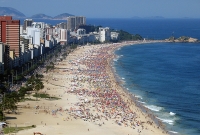
Ipanema
Immortalised in song, this Rio neighbourhood offers a legendary beach, excellent hotels, a bustling nightlife, sophisticated shopping and quality restaurants, all within walking di…
Ipanema
Immortalised in song, this Rio neighbourhood offers a legendary beach, excellent hotels, a bustling nightlife, sophisticated shopping and quality restaurants, all within walking distance of each other. Ipanema is famous for setting fashion trends, particularly in the line of swimwear, and fashion followers should look out for the famous bikini boutiques such as Salinas, Blue Man and Bum-Bum. The Rua Garcia D'Avila is perfect for designer fashion, jewellery and furniture, while the nearby Amsterdam Sauer Museum of Gems has an interesting tour of its workshop. There are plenty of other popular shopping strips here, including the eclectic commercial street Visconde de Piraja, lined with speciality shops, boutiques and restaurants, as well as the bohemian fair at General Osorio Square on Sundays, with its collection of wooden sculptures, exotic musical instruments and artworks.
Address Avenida Vieira Souto
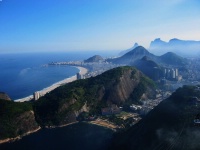
Copacabana
This famous Rio beach neighbourhood was just a small fishing village until a new highway built in the early 1900s brought crowds of visitors to its golden shores. The Copacabana Pa…
Copacabana
This famous Rio beach neighbourhood was just a small fishing village until a new highway built in the early 1900s brought crowds of visitors to its golden shores. The Copacabana Palace Hotel first opened its doors in 1923 and heralded the construction of scores of Neoclassical and Art Nouveau skyscrapers, penthouses and apartments in the area. Visitors still flock to the hotel, which is the place to be seen, especially at the famed Cipriani restaurant. The white sands and calm waters of the beach make for an idyllic setting and is also a popular spot for beach soccer, volleyball and sunbathing. Copacabana beach is particularly popular on New Year's Day, when beachgoers dress in white and celebrate in droves, with more than 2 million people crowding the beach.
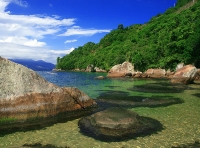
Angra dos Reis
This peninsula and group of islands is a holiday playground containing 2,000 beautiful beaches and a wonderland of mountains, forests, waterfalls, lakes and secret coves. Visitors …
Angra dos Reis
This peninsula and group of islands is a holiday playground containing 2,000 beautiful beaches and a wonderland of mountains, forests, waterfalls, lakes and secret coves. Visitors can take trips by schooner or yacht to explore the delights of the area: fishing and scuba diving are the favoured activities for tourists among various other water sports, while on land there are hundreds of walking trails giving access to some of the less frequented beaches such as Canto, Abraãozinho, Morcego and Grande das Palmas. The beaches of Aventureiro and Lopes Mendes are popular surf spots. The islands can easily be reached from Rio by road in just over three hours, or accessed by bus with daily departures every hour from the Novo Rio Bus Station.
Website www.angra-dos-reis.com
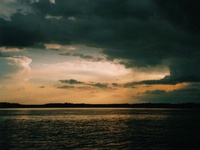
The Meeting of the Waters
The Meeting of Waters is an incredible natural phenomenon occurring when the dark waters of the Rio Negro join the lighter-coloured stream of the Rio Solimoes. The difference betwe…
The Meeting of the Waters
The Meeting of Waters is an incredible natural phenomenon occurring when the dark waters of the Rio Negro join the lighter-coloured stream of the Rio Solimoes. The difference between the blackwater and whitewater rivers is stark, running side by side for a length of more than four miles (6km) without mixing. The separation is caused by differences in temperature, density and flow, with the resultant display a true wonder of nature. Becoming a major tourist attraction in Brazil, the Meeting of Waters is accessed via an hour's boat journey from the floating docks in Manaus.
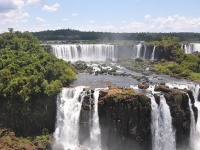
Iguaçu Falls
The Rio Iguaçu begins its journey in the coastal mountains of Paraná and Santa Catarina, snaking west for 370 miles (600km) before it widens and then plunges through the jungle i
Iguaçu Falls
The Rio Iguaçu begins its journey in the coastal mountains of Paraná and Santa Catarina, snaking west for 370 miles (600km) before it widens and then plunges through the jungle in tiered falls at the border with Argentina and Paraguay.
The Foz do Iguaçu (Iguaçu Falls) are more than two miles (3km) wide and 262ft (80m) high (almost twice the height of Niagara Falls), and their beauty is unmatched. Almost twice the height of Niagara Falls, their name fittingly comes from the Guarani Indian word meaning 'great waters'. The deep flowing waters of the river tumble down 275 falls, the most famous of which is Devil's Throat on the Argentinian border, with a drop of 230ft (70m).
As well as taking in the stunning views, visitors can enjoy kayaking and other water sports in the river. The best time of year to visit is August to November, when there is least risk of floodwaters hindering the approach to the boardwalks. The falls are surrounded by the Iguaçu National Park, a huge sub-tropical rainforest covering 135,000 acres and home to thousands of different species of animals and birds, including flamboyant parrots and pretty hummingbirds.


